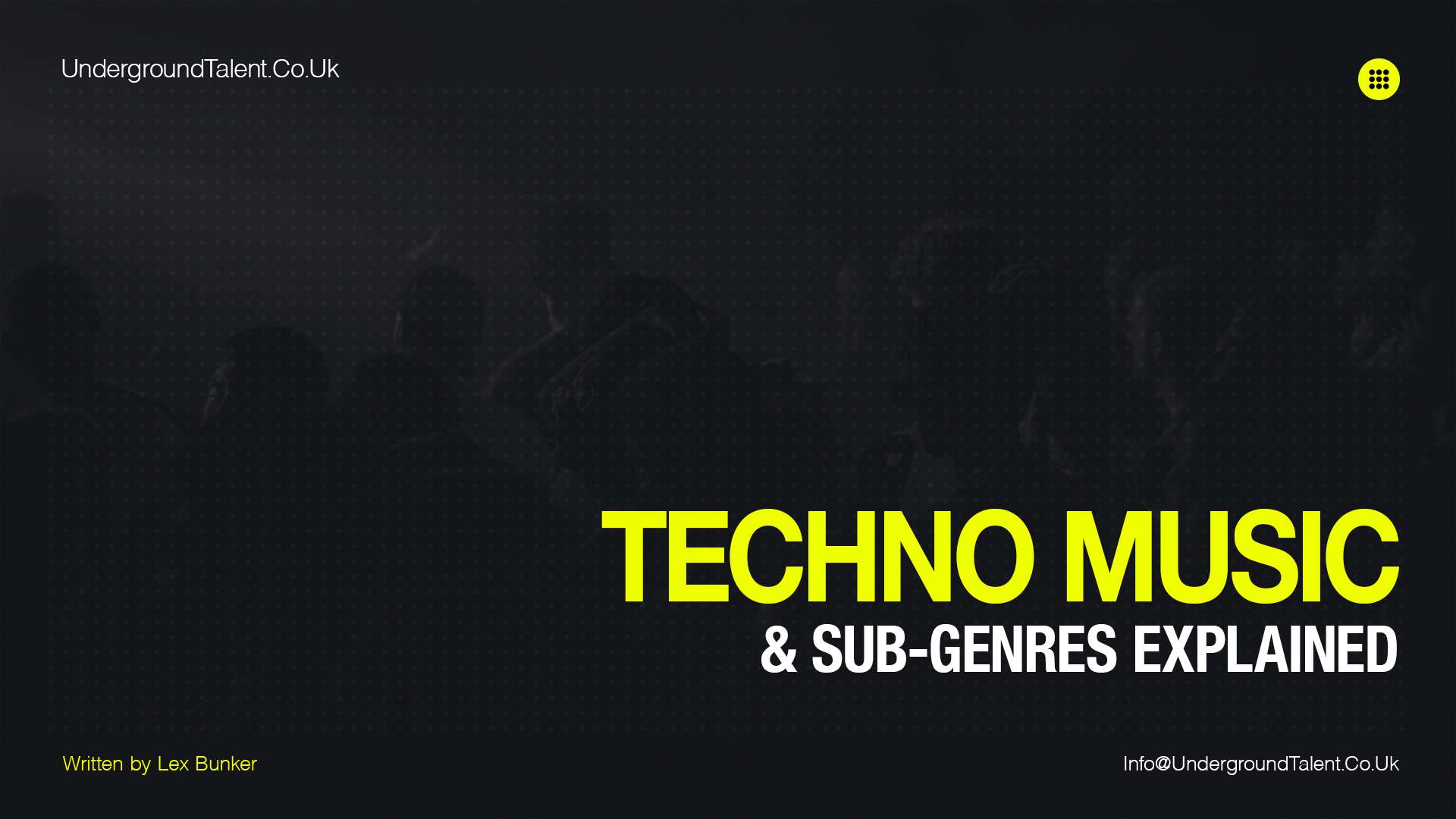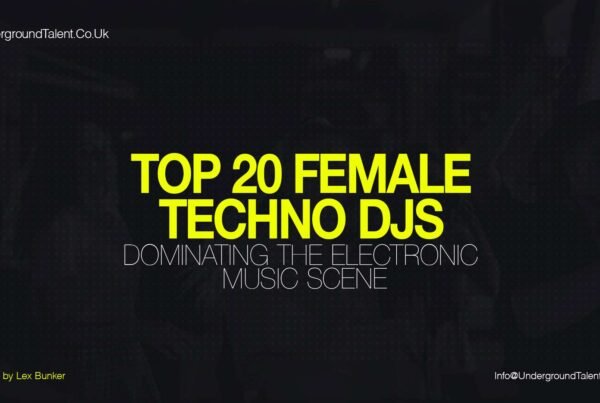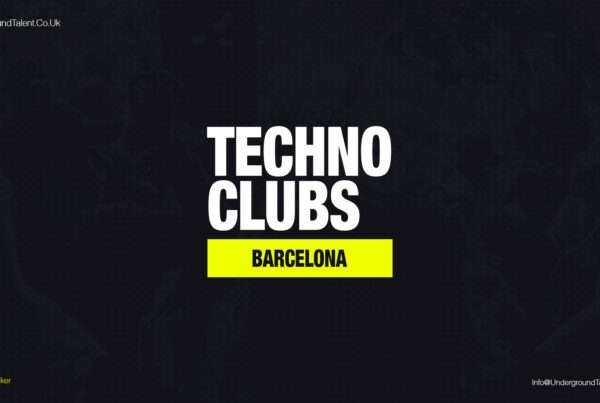Techno Music & Sub-genres Explained!

The Birth of Techno Music (Techno Music History)
The birth of techno music, an innovative genre of electronic dance music (EDM), took place in the late 1980s and 1990s. The unique aspect of techno music history lies in the electronic instruments used to produce it, including synthesizers like the Roland TB-303 and drum machines like the Roland TR-808 and TR-909.
The rise of techno music was seen throughout the 1970s and 1980s, emerging from the German electro-pop and American house music genres that were popular at the time. An integral part of techno music history is its roots in Detroit, Michigan, in the United States, where the fascination of middle-class African-American youths for European electronic dance music catalyzed the birth of techno.
The transformation of techno from an underground sound in the early ’80s to one of electronic music’s most-loved genres demonstrated its enduring appeal. The four-on-the-floor beat and innovative use of electronic instruments like drum machines, sequencers, and synthesizers are key components of techno music history.
Read Also: Interview With Mark Jenkins | A Legend of Electronic Music
The Evolution of Techno Music (Techno Music History)
Techno music history is marked by its evolution, branching into numerous styles and sub-genres. The techno music evolution has been continuous, using electronic instruments like drum machines, sequencers, synthesizers, and digital audio workstations.
Techno music history tracks the genre’s evolution from its roots in Detroit to global popularity today. Between 1992 and 1994, the focus shifted more towards home-based listening, reflecting a change in how people engaged with techno music. This period saw the birth of new sub-genres, adding unique elements to the techno soundscape.
The tempo of techno music often varies between 120 and 150 beats per minute (bpm), and techno music history has seen the genre absorbing influences from other music styles. This absorption has led to the creation of techno sub-genres like dub techno, minimal techno, and tech house.
Don’t Miss: Techno Events: How to Plan & Organize the Perfect Techno Party
The Sub-genres of Techno (Techno Music and Sub-genres)
Techno music history extends into the creation of several techno sub-genres. With its characteristic four-on-the-floor beat and a tempo between 120 to 150 BPM, techno music has spawned a variety of sub-genres. Each techno sub-genre adds to the diversity and richness of the overall techno music experience. From the high-energy beats of Peak Time Techno to the emotive melodies of Melodic Techno and the sinister mood of Dark Techno, techno music history and sub-genres offer a wide array of styles for techno enthusiasts to explore.
Techno music history and its numerous sub-genres continue to inspire artists and captivate audiences around the world, proving that the ‘beat’ of techno music is still very much alive. From its origins in the underground clubs of Detroit to its global influence, techno music history and sub-genres stand as a testament to the genre’s enduring appeal and its ability to adapt and innovate.
Read Also: Techno Sample Pack: Unleash Your Creativity with Techno Shots
What Are the Subgenres of Techno Music?
Here are all the sub-genres of techno music listed alphabetically:
- Acid Techno
- Ambient Techno
- Bleep Techno
- Breakbeat Techno
- Dark Techno
- Deep Techno
- Detroit Techno
- Dub Techno
- Electro Techno
- Ethereal Techno
- Hard Techno
- Hypnotic Techno
- Industrial Techno
- Melodic Techno
- Minimal Techno
- Peak Time Techno
- Progressive Techno
- Schranz
- Tribal Techno
Don’t Miss: Techno Loops V1: High-Quality Analog Loops for Music Production
Techno Music and Sub-genres Explained
Here are the sub-genres of techno music categorized alphabetically with examples:
Acid Techno
Acid techno is known for its aggressive and psychedelic sound, often created using the Roland TB-303 synthesizer to produce a distinctive squelchy sound.
Download Free: Techno Sample Pack: 64 One-Shot Samples + Producers Tips
Ambient Techno
This sub-genre combines the rhythmic elements of techno with the atmospheric qualities and textures of ambient music.
Read Also: Biggest Mistakes Producers Make In Electronic Music
Bleep Techno
Originating in the UK, bleep techno is characterized by the use of low bass frequencies and futuristic bleeps. It’s considered to have shaped British Bass music and influenced other EDM sounds like Grime and Dubstep.
Read Also: Email Marketing For Electronic Music Artists
Breakbeat Techno
Breakbeat Techno deviates from the traditional four-on-the-floor rhythm of techno, incorporating breakbeats and syncopated rhythms.
Read Also: What Is A DAW? A Powerful Guide for Beginners
Deep Techno
Emphasizes atmosphere and texture over rhythm, often featuring slower tempos, deeper basslines, and a more introspective mood.
Read Also: Music Press Kit – What Is It & What Does It Contain?
Dark Techno
Dark techno is characterized by its heavy, brooding, and often ominous sound. It often features distorted beats, dissonant harmonies, and a generally darker and more sinister mood compared to other techno sub-genres.
Read Also: Patriarchy in the Music Industry: Steps Towards Equality
Detroit Techno
Originating from its namesake city, Detroit Techno is considered the foundation from which all other techno sub-genres have evolved. It’s characterized by its soulful and futuristic sound, often incorporating elements of funk and electro.
Read Also: Music Production: 10 FAQs for Beginners at Level One
Dub Techno
This sub-genre combines the production techniques of dub and techno, often featuring minimalistic arrangements with heavy use of echo and reverb effects.
Read Also: Social Media Marketing Campaign for Electronic Music Artists
Electro Techno
This sub-genre combines elements of techno and electro, often featuring funky basslines, syncopated rhythms, and the use of electronic instruments like the Roland TR-808 drum machine.
Read Also: How To Promote Electronic Music on YouTube?
Ethereal Techno
This sub-genre of techno is characterized by its atmospheric, ambient, and often dreamy soundscapes. It combines the rhythmic structure of techno with elements of ambient music, often featuring lush synth pads, reverb-drenched melodies, and a generally more relaxed tempo compared to other techno sub-genres. Ethereal Techno is perfect for listeners who enjoy the rhythmic drive of techno but also appreciate the atmospheric qualities of ambient music.
Read Also: Demo Submissions: How to Send Demos to Record Labels?
Hard Techno
Hard techno is faster, heavier, and darker than most other forms of techno. It often features a fast tempo, intense percussion, and a heavy emphasis on the bassline.
Read Also: Bandcamp: How to Promote & Sell Your Music?
Hypnotic Techno
Characterized by its repetitive, trance-inducing rhythms and atmospheric soundscapes.
Read Also: How to Start a Record Label? The Ultimate Techno Guide
Melodic Techno
Melodic techno combines the rhythmic structure of techno with melodic elements, often featuring complex melodies, harmonies, and sometimes even vocals. It’s known for its emotive and often atmospheric sound.
Read Also: Patriarchy in the Music Industry: Steps Towards Equality
Minimal Techno
As the name suggests, minimal techno focuses on simplicity. It’s characterized by a stripped-down aesthetic that emphasizes rhythm and uses repetition creatively.
Read Also: Top 20 Female Techno DJs Dominating the Electronic Music Scene
Industrial Techno
Industrial techno is a hard-hitting high-energy version of techno that often uses dark, harsh, noisy, and aggressive elements associated with industrial music.
Don’t Miss: How to Stop Procrastinating & Finish Your Tracks?
Peak Time Techno
This sub-genre is characterized by its high-energy and driving beats, designed to keep the dance floor moving during the peak hours of a club night. It often features powerful basslines, intense build-ups, and euphoric drops.
Read Also: Room Acoustics: How to Test the Acoustics of Your Room?
Progressive Techno
Progressive techno is characterized by its gradual build-up and changes in energy throughout a track. It often features complex arrangements, layered sounds, and a slower, more gradual development of musical ideas compared to other techno sub-genres.
Don’t Miss: Techno Radar 003: Erald, – Episode 3 [DJ Set]
Schranz
A hard and fast techno style that originated in Germany, characterized by its aggressive beats and sounds.
Don’t Miss: Techno Sequences for u-He Diva. Designed by Erald.
Tribal Techno
This sub-genre incorporates elements of tribal music, including complex percussion patterns and ethnic musical elements.
Influential Techno Artists
Over the years, many artists have contributed to the growth and evolution of techno music. These influential techno artists have not only shaped the genre but have also inspired a new generation of artists. Some of these artists include Juan Atkins, who is often credited as the “father of techno”, Derrick May, Kevin Saunderson, Carl Cox, and Richie Hawtin, among others.
Don’t Miss: Best Techno Clubs in Paris
Juan Atkins
Juan Atkins is widely recognized as one of the pioneers of techno music and is often referred to as the “father of techno.” He played a significant role in the development of the genre, particularly in its early years in Detroit. Atkins, along with Derrick May and Kevin Saunderson, formed the Belleville Three, a group that helped define the sound of techno. Juan Atkins’ groundbreaking tracks, such as “Clear” and “Technicolor,” laid the foundation for the genre’s future growth and influenced countless artists who followed.
Don’t Miss: Rave In London? Rave Responsibly.
Derrick May
Derrick May is another influential figure in the techno scene. He is known for his innovative production techniques and distinctive sound, characterized by its futuristic and melodic elements. May’s iconic track “Strings of Life” is often hailed as one of the greatest techno tracks of all time and has had a profound impact on the genre. As a DJ and producer, Derrick May continues to inspire and push the boundaries of techno music.
Read Also: How to Start a Record Label? The Ultimate Techno Guide
Kevin Saunderson
Kevin Saunderson is renowned for his contributions to the development of techno, particularly through his work as a producer and member of the Belleville Three. Saunderson’s tracks, such as “Good Life” and “Big Fun,” became anthems of the Detroit techno movement and helped popularize the genre on a global scale. His musical style incorporates elements of soul, funk, and gospel, creating a unique blend that has influenced generations of techno artists.
Don’t Miss: Cinematic u-he Diva Presets | Metropol
Jeff Mills
Jeff Mills is an iconic figure in the world of techno music. He is known for his innovative approach to DJing and production, as well as his influential role in shaping the Detroit techno sound. Mills began his career as a DJ in the early 1980s and later co-founded the legendary techno collective Underground Resistance.
Mills’ unique style and technical skills behind the decks have earned him a reputation as one of the best techno DJs in the world. He is known for his precise mixing, seamless transitions, and his ability to create an immersive and captivating atmosphere on the dance floor. Mills’ DJ sets often incorporate a wide range of genres and showcase his vast musical knowledge, taking listeners on a sonic journey through techno, house, electro, and beyond.
As a producer, Jeff Mills has released numerous groundbreaking tracks and albums that have left a lasting impact on the techno genre. His music is characterized by its futuristic soundscapes, driving rhythms, and intricate programming. Tracks like “The Bells,” “The Wizard,” and “Purpose Maker” have become timeless classics and have cemented Mills’ status as an innovator in electronic music.
In addition to his DJing and production work, Mills is also a visionary and conceptual artist. He has collaborated with orchestras and performed live soundtracks to classic silent films, exploring the intersection of techno music and visual art. Mills’ approach to music goes beyond the dance floor, as he constantly pushes the boundaries of what techno can be, experimenting with new sounds, technologies, and artistic concepts.
Jeff Mills’ impact on the techno scene extends far beyond his music. His dedication to the craft, his passion for pushing boundaries, and his uncompromising artistic vision have inspired countless artists and continue to shape the future of techno music. Whether through his dynamic DJ sets, innovative productions, or thought-provoking artistic endeavours, Jeff Mills remains a true pioneer and an influential force in the world of techno.
Read Also: The Rave Diet: What to Eat After Rave to Recover?
Carl Cox
Carl Cox is a legendary figure in the techno and electronic music scene. With his energetic DJ sets and charismatic stage presence, Cox has captivated audiences worldwide. He has played a crucial role in spreading the techno sound globally and has been instrumental in shaping the genre’s development. Cox’s passion for techno and his commitment to delivering unforgettable performances have made him an influential figure and an inspiration to countless aspiring artists.
Don’t Miss: Audio Mastering: How to Prepare Your Tracks for Mastering.
Richie Hawtin
Richie Hawtin, also known by his stage name Plastikman, is a highly influential techno artist and DJ. His experimental approach to techno and his use of cutting-edge technology in his performances have pushed the boundaries of the genre. Hawtin’s minimalist and intricate productions, such as the “Spastik” series, have garnered critical acclaim and have left a lasting impact on the techno community. As an innovator and a visionary, Richie Hawtin continues to shape the evolution of techno music.
These artists, along with many others, have made significant contributions to the growth and evolution of techno music. Through their pioneering spirit, groundbreaking tracks, and relentless dedication to pushing the boundaries of the genre, they have inspired a new generation of techno artists and continue to shape the future of electronic music.
Read Also: Bandcamp: How to Promote & Sell Your Music?
The Impact of Techno Music (Electronic Dance Music)
Techno music has had a profound impact on the broader landscape of electronic dance music (EDM). Since its inception in the late 1980s, techno has played a pivotal role in shaping the sound and style of numerous other genres within the EDM realm. Its distinctive rhythms, innovative production techniques, and futuristic aesthetics have left an indelible mark on the evolution of electronic music as a whole.
One of the most significant contributions of techno music to the EDM scene is its rhythmic structure. Techno is characterized by its driving, four-on-the-floor beats, typically set at a tempo of around 120-130 beats per minute. This consistent and pulsating rhythm has become a foundation for various EDM genres, including house, trance, and even dubstep. The infectious groove of techno has influenced countless producers and DJs, shaping the way they approach rhythm and percussion in their own music.
Techno’s emphasis on experimentation and innovation has also had a profound impact on the broader EDM landscape. From its early days in Detroit, techno pushed the boundaries of electronic music production and sound design. Artists like Juan Atkins, Derrick May, and Kevin Saunderson, among others, embraced new technologies and pushed the limits of what was possible with synthesizers, drum machines, and sequencers. This pioneering spirit paved the way for advancements in electronic music production and inspired a new generation of artists to push the boundaries of their own creativity.
Another significant aspect of techno’s impact on EDM is its futuristic and otherworldly aesthetics. Techno’s soundscapes often evoke a sense of space, futurism, and industrial landscapes. This visual and sonic imagery has influenced not only the music videos and album artwork within the techno genre but also the broader visual identity of EDM as a whole. The use of futuristic visuals, sci-fi themes, and immersive stage designs in EDM festivals and performances can be traced back to the influence of techno music.
Read Also: Demo Submissions: How to Send Demos to Record Labels?
Conclusion: Techno Music and sub-genres explained
Moreover, techno music has played a crucial role in the development of the global EDM scene. Techno festivals, such as Awakenings, Movement, and Time Warp, attract thousands of music enthusiasts from around the world, showcasing the genre’s global reach and influence. These events provide a platform for both established techno artists and emerging talents to showcase their music and connect with a passionate and dedicated fanbase. The popularity of techno festivals has contributed to the growth of the broader EDM festival culture, with electronic music events becoming a staple of the global music calendar.
In conclusion, techno music has had a profound impact on the broader landscape of electronic dance music. Its rhythmic structure, experimental approach, futuristic aesthetics, and global festival culture have influenced the sound, style, and visual identity of EDM genres across the board. Techno continues to evolve and inspire artists and listeners alike, cementing its status as a significant force in the global music scene.
Read Also: Brutalism by Erald (Free Sample Pack)
Connect With Underground Talent
You can find us on Facebook, Soundcloud, and Instagram. We encourage you to share your thoughts and feedback on this article, and we look forward to continuing to educate and inform you on this important topic. You can find us on, and, and don’t hesitate to reach out to us if you have any questions or comments by email at info@undergroundtalent.co.uk.
Don’t miss out on the latest and greatest underground talent! Subscribe to our YouTube channel now and stay on top of the freshest and most exciting new acts in the techno scene. Click the subscribe button and join our community of techno music lovers today!
Read Also: Interview With Mark Jenkins | A Legend of Electronic Music
And Always Remember…
Have Fun & Be Creative!
Read Also: How to Build a Successful DJ Career | 10 Tips & Strategies




